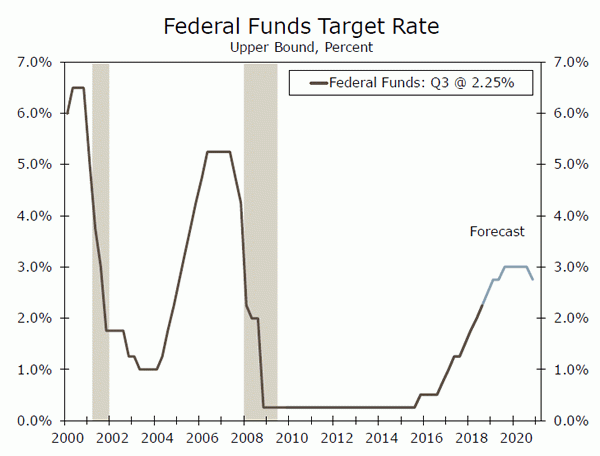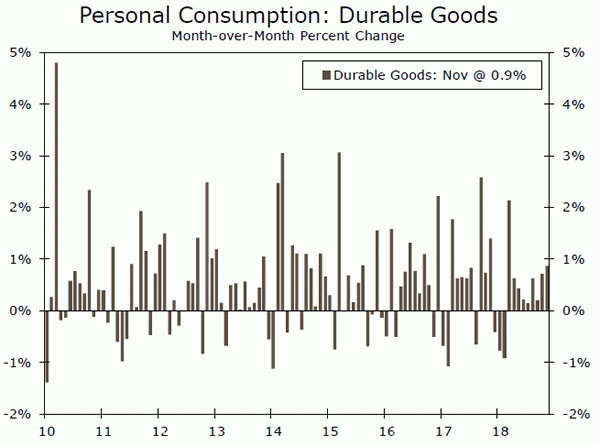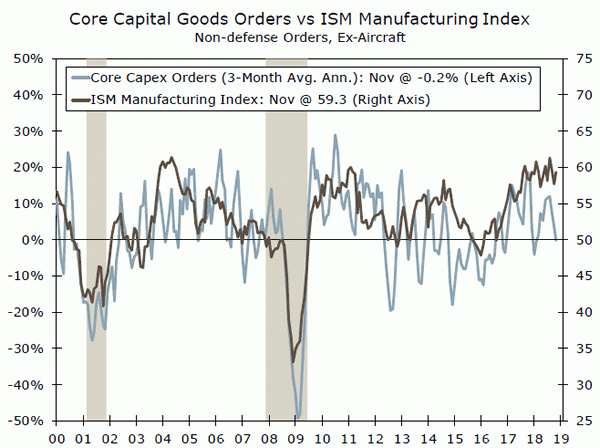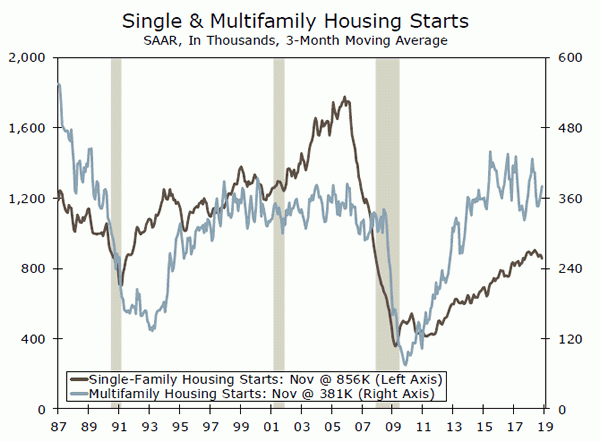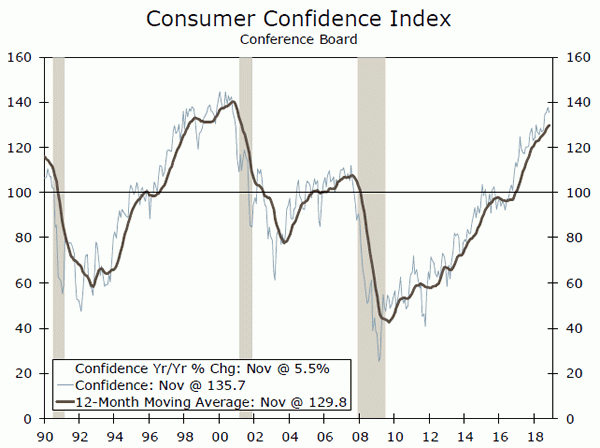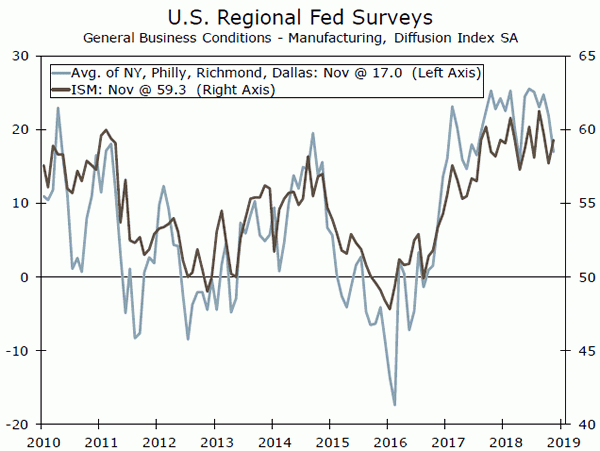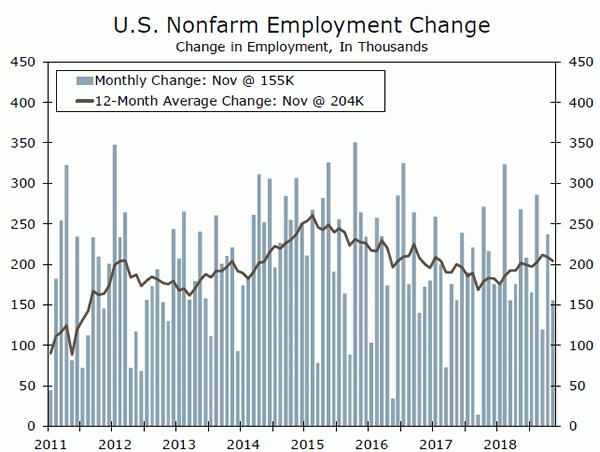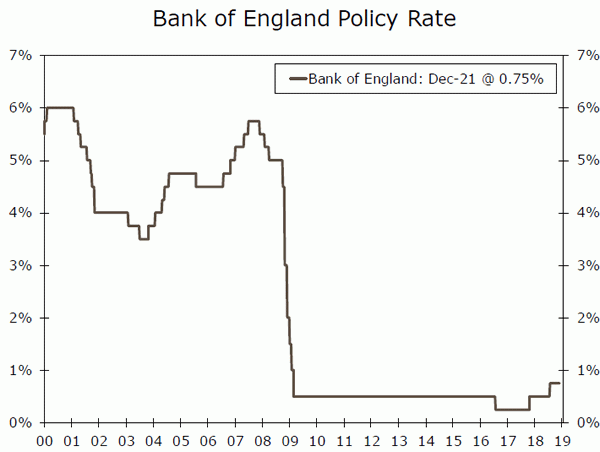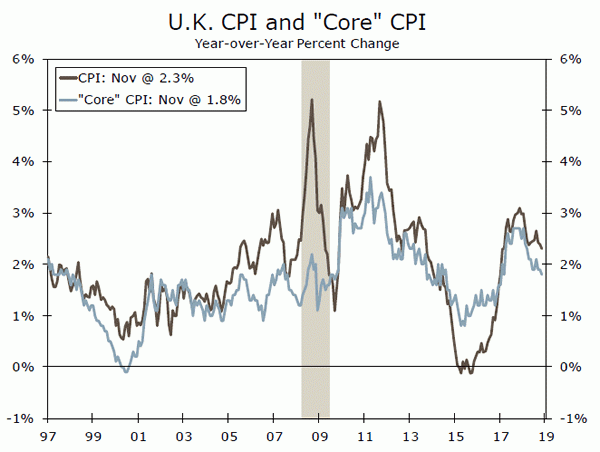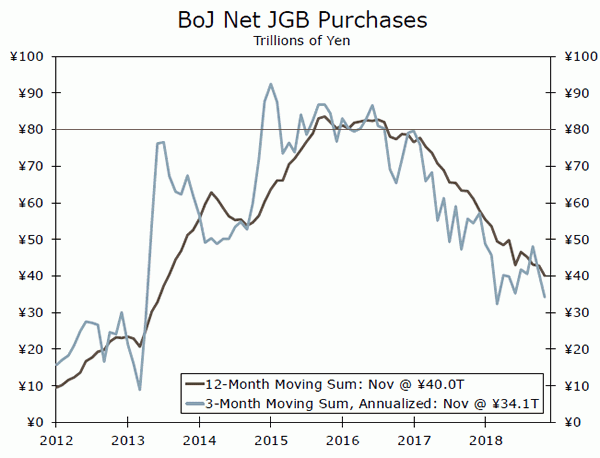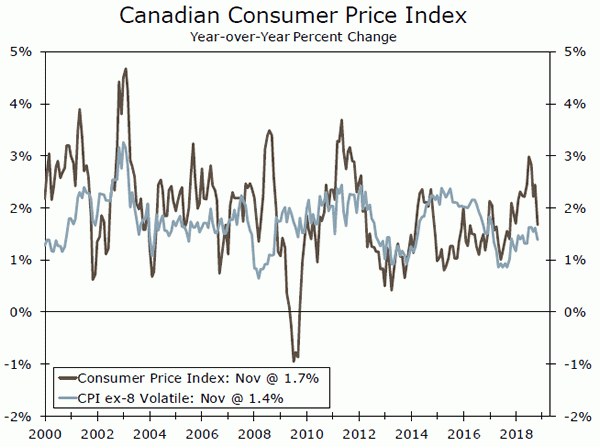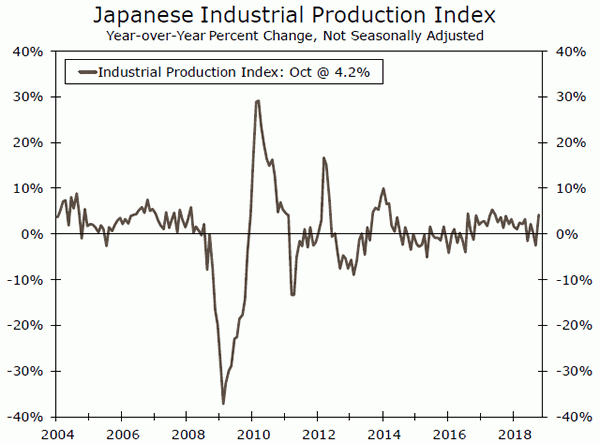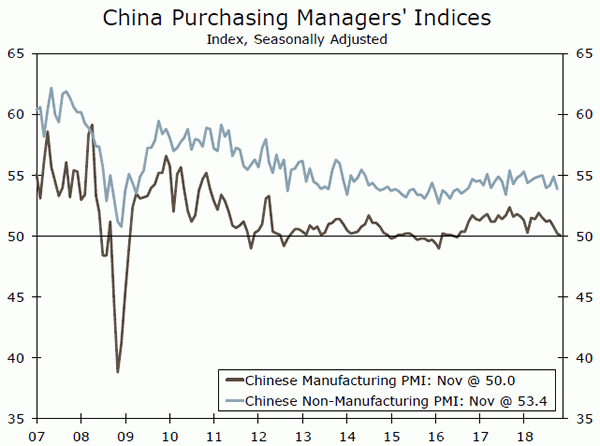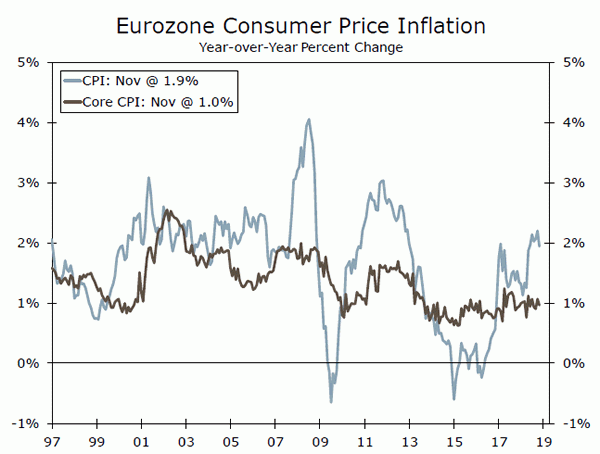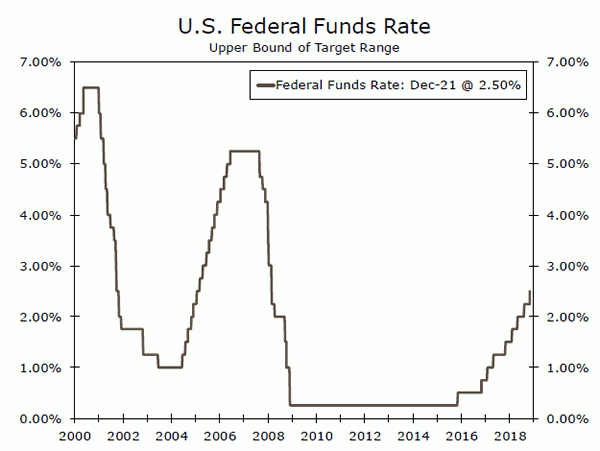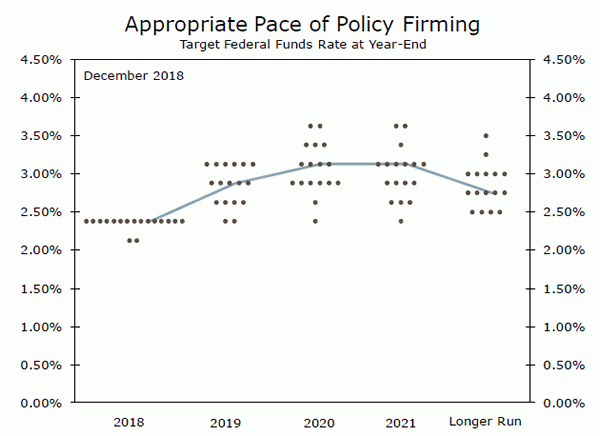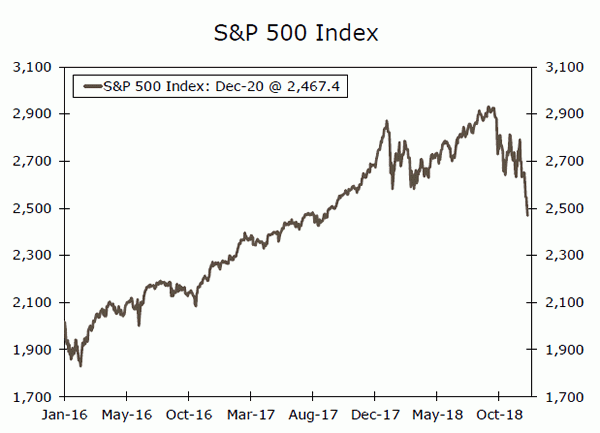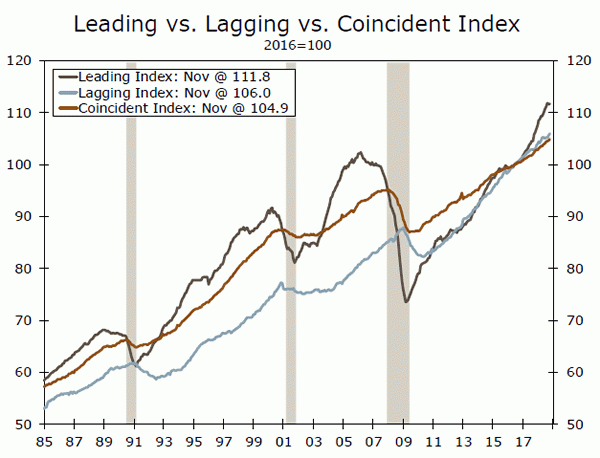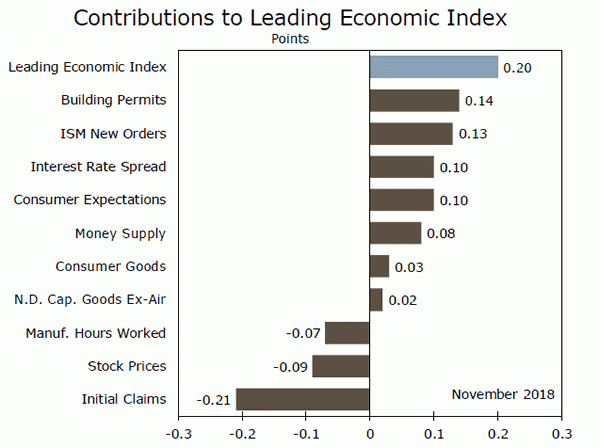U.S. Review
Data Show Still Solid, but Moderating, Momentum in Q4
- Despite some softer-than-expected data in recent weeks and continued volatility in the financial markets, the FOMC raised the fed funds rate 25 bps at its policy meeting on Wednesday.
- If, as we expect, growth remains solid in coming months, then we think our outlook for future rate hikes, albeit at a slower pace, remains reasonable.
- Economic data out the gate this week generally supports the still solid, yet moderating, pace of growth. Personal income and spending data showed consumer spending continues to rise, while fresh housing data suggest some modest improvement to end an otherwise year of cooling.
Data Show Still Solid, but Moderating Momentum in Q4
It was only a few weeks ago that there was nearly a universal agreement among analysts that the Federal Open Market Committee (FOMC) would hike rates at its December 19 monetary policy meeting. But softer-than-expected data in recent weeks and volatility in financial markets led some analysts to expect that the FOMC might refrain from tightening. Stocks had rallied just before the Fed’s decision was released on Wednesday, but, as we expected, the FOMC raised the fed funds rate 25 bps. The Fed has now hiked rates 225 bps over the past three years, 100 bps of which have occurred in 2018.
The FOMC is attempting to move away from a pre-determined policy path. It sees balanced risks to the economic and inflation outlook, and reaffirmed its data-dependent approach in the policy statement. The FOMC also dialed back its assessment for future tightening while recognizing some moderation in growth by reducing its GDP growth forecast. But, the recent policy decision to raise rates and continue its trajectory for quantitative tightening has left many analysts and market participants worried. Analysts have been questioning whether the Fed might make a policy mistake or if markets are purely overreacting. For now, we all must wait and see how the economy evolves over the next year or so. If, as we expect, growth remains solid in the coming months, then we think that the outlook for future rate hikes, albeit at a slower pace, remains reasonable. We expect the Fed to hike rates 50 bps in 2019 (chart on first page).
Economic data out the gate generally support a still solid, yet moderating, pace of growth. Personal income and spending data showed consumer spending continuing to rise at a steady rate. A sturdy consumer backdrop points to solid growth in Q4 consumption, and despite increasing interest rates November’s release showed some newfound strength in durable goods spending (top chart). Steady gains in the hard data helped keep the University of Michigan’s measure of consumer sentiment elevated in December. This is despite worries of extended drops in financial markets and softness in the housing sector. Durable goods orders rose in November, but core orders have slowed recently (middle chart). Core orders reaffirm our view that the pace of equipment spending is likely to slow in 2019 due to slower global growth and trade tensions starting to weigh on U.S. activity.
The housing sector has been a laggard of late, but fresh November data suggests some modest improvement. Housing starts jumped a better-than-expected 3.2%, although this was concentrated in the multifamily segment. Single-family starts fell for the third consecutive month (bottom chart). The 5% rebound in building permits over the month was also led by multifamily permits. Existing home sales rose 1.9%, which was better than the consensus estimate of a 0.4% drop.
Most of the anecdotal evidence surrounding the housing sector suggests that after cooling off this past summer, conditions are stabilizing at a more modest level. But, we expect the recent pullback in interest rates may provide a short rush of activity from buyers that were put off by a sudden rise in mortgage rates.
U.S. Outlook
Consumer Confidence • Thursday, Dec. 27
Consumers’ holiday cheer was probably dampened by the sharp slide in equity markets over the past month, but we expect the December consumer confidence report to show that households remained fairly upbeat on the economy. The nearly 15% drop in gasoline prices since November is padding consumer wallets just in time for holiday spending. In addition, we expect confidence to remain high given the tight state of the labor market and relatively wide availability of jobs.
Buoyant consumer spending is a key to our above-consensus outlook for growth next year. A sharper pullback in consumer confidence could therefore spook the FOMC and contribute to the committee raising interest rates less than the 50 bps we currently expect for 2019. If consumer confidence rises, however, the increase would illustrate that momentum for the household sector and broader economy remains favorable heading into 2019.
Previous: 135.7 Wells Fargo: 133.7 Consensus: 133.6
ISM Manufacturing • Thursday, Jan. 3
Manufacturing activity, according to the ISM index, rebounded in November, but has come off the highs reached over the past year. We believe there may be further moderation in the December readings. Regional purchasing managers’ indices have rolled over more definitively over the past few months. More fundamentally, moderating U.S. and global growth and trade uncertainty suggest the lofty readings of 2018 will be difficult to maintain.
A weaker-than-expected print for December could amplify concerns about slowing growth and trade tensions for markets and Fed officials alike. If the ISM index stays in the upper 50s or comes in even stronger, it would suggest that the real economy remains strong and would support another Fed hike in the first quarter.
Previous: 59.3 Wells Fargo: 58.2 Consensus: 58.2
Employment • Friday, Jan. 4
Hiring has slowed recently, with employers adding an average of 170,000 jobs over the past three months versus 211,000 in the first 10 months of the year. We see some scope for hiring to rebound after last month’s 155,000 gain, but the trend is likely to remain below 200,000. While demand for workers remains solid, as indicated by the near-record high in job openings, low unemployment is making it more difficult for firms to hire new workers. We expect the unemployment rate to remain at a 49-year low of 3.7%.
While estimates suggest about only 100,000 jobs are needed each month to keep the unemployment rate declining on trend, another significant downside miss would suggest the labor market is cooling faster than the Fed is likely to be comfortable with. That would suggest the timing of future rate hikes would likely be pushed back. An upside surprise, on the other hand, would be supportive of the additional two rate hikes in 2019 the Fed projected this week.
Previous: 155,000 Wells Fargo: 175,000 Consensus: 180,000
Global Review
Monetary Policy Mixed Bag to End the Year
- Several central bank announcements this week confirm our view of monetary policy convergence continuing gradually over the coming year. The Riksbank unexpectedly raised rates along with central banks in Thailand and Mexico, while the Bank of England and Bank of Japan remained on hold.
- Italy reached a budget deal with the EU this week, avoiding sanctions for its initial failure to comply with the EU’s deficit limit of 2% of GDP.
- Solid data out of Canada support our view that the Bank of Canada could raise interest rates multiple times next year.
Monetary Policy Mixed Bag to End the Year
Global monetary policy took center stage this week amid several central bank announcements. In the U.K., the Bank of England (BoE) left rates unchanged as Brexit uncertainty continues to weigh on growth prospects (see chart on page 1). We learned this week that inflation continued to slow back toward the BoE’s 2% target in November (top chart), and retail sales rebounded 1.2%. But at the same time, Brexit tensions have risen recently—Prime Minister May survived a leadership challenge just last week, while the initial deal reached with the EU earlier this month has yet to come before parliament for a vote. We look for the BoE to remain on hold until a final agreement comes into sharper focus. Our base case is still for a deal to be reached by the March 29 deadline, and we look for the BoE to then raise rates in Q2-2019.
Meanwhile, in Sweden, the Riksbank raised rates 25bps for the first time since 2011, although the consensus was expecting rates to remain unchanged until February. The decision comes amid a recent soft patch in GDP growth and inflation that hit the central bank’s “around 2%” target in November, but policymakers also reduced projections for future rate hikes, meaning they will likely proceed cautiously with additional tightening.
Elsewhere in Europe, Italy reached an agreement with the EU to lower its deficit target to 2.04% of GDP in 2019. The deal avoids sanctions threatened as a result of Italy’s original failure to comply with the EU’s requirements. Although the deal avoids drawn out negotiations that could have been a headwind to the broader Eurozone economy, structural issues facing Italy such as high government debt levels and sluggish economic growth mean its economy will likely remain in focus over the coming months.
Turning to Asia, the Bank of Japan (BoJ) left rates unchanged this week, maintaining its ultra-accommodative policy stance amid low inflation. That said, the BoJ introduced slight policy tweaks in July to allow for a wider trading range on Japanese government bond (JGB) yields. And, while its annual JGB purchase target remains at ¥80 trillion, the BoJ has actually been steadily reducing net purchases closer to a ¥40 trillion annual pace (middle chart). We still look for the BoJ to raise its policy rate to 0% from -0.10% as soon as Q2-2019. Elsewhere in the region, Thailand’s central bank raised rates 25bps, while central banks in Taiwan and Indonesia remained on hold, consistent with the broader theme of global monetary policy convergence proceeding only gradually in the coming quarters.
Finally, in North America, Mexico’s central bank raised its policy rate 25 bps to 8.25%, the highest since 2008, in an attempt to curb further peso weakness and still-above-target inflation. In Canada, November inflation and October GDP and retail sales data were also released this week. Headline CPI rose a more tepid 1.7% year over year, largely due to the recent drop in oil prices (bottom chart). However, core inflation still remains near the center of the Bank of Canada’s (BoC) 1-3% target band. A pickup in GDP growth to 2.2% year over year in October along with firming retail sales suggest that, so long as oil prices recover, the BoC could still raise interest rates multiple times next year.
Global Outlook
Japan IP • Thursday, Dec. 28
Following a contraction in Japan’s economy in Q3, monthly activity indicators are being watched closely for signs of a return to growth in Q4. The early indicators are encouraging, with October industrial production rising 2.9% month over month and October retail sales rising 1.3% month over month. Next week sees the release of November activity data, for which economists forecast a partial payback for that October strength. The consensus forecast is for industrial production to fall 1.7%, while retail sales are also expected to fall 0.4%. Even with those declines, however, Japanese growth is expected to return positive territory in Q4, with the consensus forecast for Q4 GDP currently at 2.2% quarter-over-quarter annualized pace. Next week also sees the release of the Tokyo December CPI, a timely and leading indicator of the national CPI. The Tokyo CPI excluding fresh food is forecast to rise 0.9% year over year, a bit less than the November gain.
Previous: 2.9% (Month-over-Month) Consensus: -1.7%
China PMIs • Monday, Dec. 31
China’s economy has been on a steadily slowing path, with trade tensions with the United States reinforcing already subdued domestic economic trends. The manufacturing and service sector PMIs provide timely insight into the path of the economy, and have displayed consistent weakness in recent months. The manufacturing PMI fell to 50.0 in November, the lowest reading since mid-2016.
The services PMI has also eased, although activity has been somewhat more resilient, with the November reading of 53.4 matching the lowest level since mid-2017. Despite growth supportive monetary and fiscal policies China’s economic slowdown has so far shown few signs of dissipating, and in that context the December PMI surveys will be scanned for any hints of stabilization. The outlook remains tentative however. For December, the manufacturing PMI is expected to stay at 50.0, while the services PMI is expected to fall further to 53.1.
Previous: 50.0 (Manufacturing), 53.4 (Services) Consensus: 50.0 (Manufacturing), 53.1 (Services)
Eurozone CPI • Friday, Jan. 4
Inflation pressures remain moderate across the Eurozone. The CPI rose 1.9% year over year in November, while in recent months the headline reading has exceeded 2% at times, boosted by higher energy, and to a lesser extent, food prices. Underlying inflation pressure have so far remained relatively subdued, however, with services inflation at 1.3% year over year in November, and the core CPI rising by just 1.0%. The European Central Bank recently confirmed its plans to end its asset purchase program at the end of this year, although the lack of inflation pressure means the central bank is not expected to begin raising interest rates until late in 2019.
For December, the CPI should continue to indicate few inflation pressures for now. Given the recent drop in oil prices, the headline CPI is expected to slow further to 1.8%. Meanwhile core CPI inflation has ranged between 0.9% and 1.1% since May this year, and should stay within that range in December with a 1.0% gain.
Previous: 1.9% (Year-over-Year) Consensus: 1.8%
Point of View
Interest Rate Watch
The Fed Hikes Rates 25 bps
As expected by most observers, the Federal Open Market Committee (FOMC) raised its target range for the fed funds rate by 25 bps at its meeting on December 19 (top chart). But the committee dialed back its assessment for further tightening. The median FOMC member now sees the need for just 50 bps of additional tightening next year instead of 75 bps (middle chart), and the FOMC said that it “will continue to monitor global economic and financial developments and assess their implications for the economic outlook.”
That said, market participants were clearly not happy with the FOMC’s judgement that further monetary tightening will be needed. The stock market has swooned (bottom chart), and prices of corporate bonds, especially speculative grade bonds, have weakened sharply.
The U.S. economy is humming along right now, but real GDP growth clearly has slowed from its breakneck pace earlier this year. The housing market has more or less stalled. Slower economic growth in the rest of the world has weighed on U.S. export growth, and the recent collapse in energy prices dampens the outlook for capital spending in the energy sector. Measures of business optimism have ticked lower, and the aforementioned weakness in financial markets impart a tightening of financial conditions on the economy. This tightening in financial conditions, if maintained, reduces the need for further Fed tightening, everything else equal.
We have expected for some time that the U.S. economy would decelerate in 2019 as the effects of fiscal stimulus wane and as previous Fed rate hikes exert headwinds on interest-rate-sensitive spending. But we maintain our forecast that the economy will continue to grow at a solid pace next year, albeit slower than in 2018, and that the FOMC will raise rates by 50 bps (once in March and once in September) in 2019. That said, the recent tightening of financial market conditions imparts some uncertainty into the timing and magnitude of future rate hikes. Similar conditions in 2015/early 2016 led the FOMC to remain on hold for most of 2016. We will be keeping a close eye on the economy and will make adjustments to our interest rate forecasts, if warranted.
Credit Market Insights
Leverage Loans and the U.S. Economy The leveraged loan market, where bank debt of non-investment grade companies is traded, has experienced rapid growth over the past few years. Weakness in the market in recent weeks, however, may bring back unpleasant memories of the sub-prime loan debacle a decade ago. Does this recent weakness in the leveraged loan market have negative implications for the U.S. economy?
The leveraged loan market in the United States has mushroomed to more than $1 trillion today from only $5 billion about 20 years ago (Figure 1). Growth has been especially marked in the past two years, with the amount of leveraged loans outstanding up more than 30% since late 2016.
In our view, the leveraged loan market, taken in isolation, is not likely to bring the economy to its knees anytime soon. Past weakness in leveraged loans has generally not been associated with a marked deceleration in bank C&I lending. But its recent weakness may reflect a broader economic reality about which we have been writing. Namely, the overall financial health of the non-financial corporate sector has deteriorated modestly over the past few years. If the Fed continues to push up interest rates and if corporate debt continues to rise, then financial conditions would tighten further, which could eventually lead to a sharper slowdown, if not an outright downturn, in economic growth.
For further reading on this topic, see our recent special report “Leverage Loans: A Deathknell for the U.S. economy?”
Topic of the Week
Do you See What I See?
With a looming government shutdown, choppy financial markets and a 25 bps rate hike by the FOMC, markets continued to be plagued with volatility this week. We believe the economy has decelerated a bit in recent months, but growth clearly remains positive. A recent example of this notion is the Leading Economic Index (LEI), which rose 0.2% in November, but was accompanied with a decent downward revision to October. Moderation here is consistent with recent market volatility, and indicative of a moderation in economic growth in the year ahead.
Strength in the underlying components was broad based, with seven of the ten underlying indicators contributing positively to the index. Broad declines in stock prices throughout the month of November held back the stock price component, and given continued declines in financial markets through December, it is unlikely for this component to reverse next month. Initial jobless claims were the largest drag for the November LEI, as the month saw the greatest pick up in claims since March. But, claims rose to only 214,000 last week, after a sharp drop to 206,000 claims during the first week in December. The housing sector has seen a moderation over the past year, as sales and price appreciation have cooled off considerably. But the most recent data suggest conditions are stabilizing at a more modest level.
Building permits rose a better-than-expected 5.0% in November, and were the largest contributor to the LEI, adding 0.14 points. Not too far behind, the ISM new orders component contributed 0.13 points to the overall LEI. The jump in November orders points to continued gains in the factory sector, but given that the gap between the ISM new orders index and core capital goods orders remains fairly wide, we remain cautious of the near-term capital spending plans.
Growth is expected to moderate in the year ahead, but looking past choppy markets and volatile news headlines, economic growth remains broadly positive.




